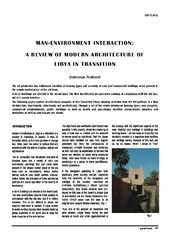Приказ основних података о документу
Man-environment interaction: A review of modern architecture of Libya in transition
| dc.creator | Tošković, Dobrivoje | |
| dc.date.accessioned | 2018-12-26T10:54:07Z | |
| dc.date.available | 2018-12-26T10:54:07Z | |
| dc.date.issued | 2006 | |
| dc.identifier.issn | 1450-569X | |
| dc.identifier.uri | https://raumplan.iaus.ac.rs/handle/123456789/109 | |
| dc.description.abstract | The oil production has influenced evolution of housing types and a variety of civic and commercial buildings never present in the simple market place of the old town. A lot of buildings are erected in the recent past. The New Architecture became more sanitary in comparison with the old one, but it is mainly formless. The following pages explore architectural examples of this Transitory Phase showing evolution from the Old patterns to a New Architecture, functionally, structurally and aesthetically. Through a set of the newly introduced housing types, new mosques, commercial establishments, public buildings as well as health and educational facilities characteristic progress and deviations as well as new lessons are shown. | en |
| dc.publisher | Institute of Architecture, Urban & Spatial Planning of Serbia | |
| dc.rights | openAccess | |
| dc.rights.uri | https://creativecommons.org/licenses/by-nc-nd/4.0/ | |
| dc.source | Spatium | |
| dc.title | Man-environment interaction: A review of modern architecture of Libya in transition | en |
| dc.type | article | |
| dc.rights.license | BY-NC-ND | |
| dcterms.abstract | Тошковић, Добривоје; | |
| dc.citation.issue | 13-14 | |
| dc.citation.spage | 47 | |
| dc.citation.epage | 54 | |
| dc.citation.other | (13-14): 47-54 | |
| dc.identifier.doi | 10.2298/SPAT0614047T | |
| dc.identifier.fulltext | https://raumplan.iaus.ac.rs//bitstream/id/1459/106.pdf | |
| dc.type.version | publishedVersion |

